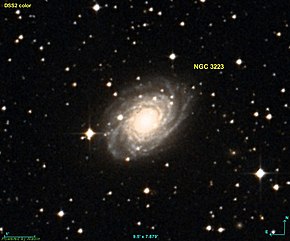NGC 3223 is a faint spiral galaxy in the constellation Antlia.[5] It was discovered on February 2, 1835 by the English astronomer John Herschel.[6] The galaxy lies at a distance of approximately 110 million light years away and is receding with a heliocentric radial velocity of 2,896 km/s.[3]
| NGC 3223 | |
|---|---|
 DSS image of NGC 3223 | |
| Observation data (J2000 epoch) | |
| Constellation | Antlia |
| Right ascension | 10h 21m 35.076s[1] |
| Declination | −34° 16′ 00.44″[1] |
| Redshift | 0.009704[2] |
| Heliocentric radial velocity | 2,896 km/s[3] |
| Distance | 109.5 Mly (33.57 Mpc)[3] |
| Apparent magnitude (V) | 10.82[2] |
| Apparent magnitude (B) | 11.82[2] |
| Characteristics | |
| Type | SA(s)b, Sb(s)I-II[4] |
| Other designations | |
| IC 2571, MCG -06-23-023, PGC 30308[2] | |
Morphology
editThe morphological class of NGC 3223 is SA(s)b,[4] indicating it is a spiral with no central bar (SA), no inner ring feature, and moderately tightly wound spiral arms. The galactic plane is inclined at an angle of 46° to the line of sight from the Earth, with the major axis along a position angle of 128°. It has at least two well-defined arms and is flocculent in appearance.[7]
NGC 3223 group
editNGC 3223 is the brightest and largest member of a galaxy group named after it. There are 16 members including NGC 3224, NGC 3258, NGC 3268, NGC 3289, IC 2552, IC 2559 and IC 2560.[8] Together, the NGC 3223 Group forms a part of the Antlia Cluster.[9]
References
edit- ^ a b Skrutskie, Michael F.; et al. (February 1, 2006). "The Two Micron All Sky Survey (2MASS)". The Astronomical Journal. 131 (2): 1163–1183. Bibcode:2006AJ....131.1163S. doi:10.1086/498708. ISSN 0004-6256. S2CID 18913331.
- ^ a b c d "NGC 3223". SIMBAD. Centre de données astronomiques de Strasbourg. Retrieved 2021-02-19.
- ^ a b c Tully, R. Brent; et al. (August 2016). "Cosmicflows-3". The Astronomical Journal. 152 (2): 21. arXiv:1605.01765. Bibcode:2016AJ....152...50T. doi:10.3847/0004-6256/152/2/50. S2CID 250737862. 50.
- ^ a b Eskridge, Paul B.; et al. (November 2002). "Near-Infrared and Optical Morphology of Spiral Galaxies". The Astrophysical Journal Supplement Series. 143 (1): 73–111. arXiv:astro-ph/0206320. Bibcode:2002ApJS..143...73E. doi:10.1086/342340. S2CID 15491635.
- ^ Dunlop, Storm (2005). Atlas of the Night Sky. Collins. ISBN 978-0-00-717223-8.
- ^ Seligman, Courtney. "New General Catalogue objects: NGC 3200 - 3249". cseligman.com. Retrieved 2021-02-19.
- ^ Grosbol, P. J.; Patsis, P. A. (August 1998). "Stellar disks of optically flocculent and grand design spirals. Decoupling of stellar and gaseous disks". Astronomy and Astrophysics. 336: 840–854. Bibcode:1998A&A...336..840G.
- ^ Garcia, A. M. (1993-07-01). "General study of group membership. II. Determination of nearby groups". Astronomy and Astrophysics Supplement Series. 100: 47–90. ISSN 0365-0138.
- ^ Hopp, U.; Materne, J. (1985-07-01). "The Antlia cluster of galaxies and its environment : the Hydra I-Centaurus supercluster". Astronomy and Astrophysics Supplement Series. 61: 93–106. ISSN 0365-0138.
External links
edit- "Results for object NGC 3223 (NGC 3223)". NASA/IPAC Extragalactic Database. California Institute of Technology. Retrieved 2021-02-19.